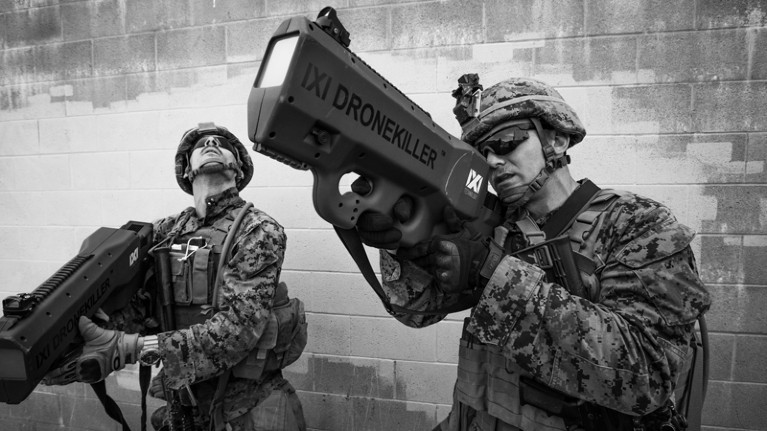
As governments press academics into military research, universities should make clear what they stand for.Credit: Lance Cpl Rhita Daniel/US Marine Corps/DVIDS
South Korea is understandably nervous. To the north, a bellicose, belligerent and unpredictable leader has nuclear weapons, increasingly powerful missiles and many troops. South Korea is trying to counter that with technological superiority offered by its robust scientific infrastructure. But the nation’s efforts to enhance the technological superiority by using academics to pursue military goals have raised a furore. And South Korea is not the only country to court such controversy.
In February, South Korea opened a centre at its premier research facility, the Korea Advanced Institute of Science and Technology (KAIST) in Daejeon, in collaboration with the country’s leading arms manufacturer, Hanwha Systems. Media reports said that the centre, known as the Research Centre for the Convergence of National Defence and Artificial Intelligence, would develop technologies that could be useful for more-advanced weapons, such as missiles that use artificial intelligence (AI) to control their speed and altitude and detect enemy radar in real time.
There was an immediate backlash. Almost 60 AI and robotics researchers from around the world signed an open letter opposing KAIST’s participation in an autonomous-weapons race. They threatened to cut all ties with KAIST. But this episode had a happy ending: KAIST’s president vowed that the centre wouldn’t develop lethal weapons. The boycott was abandoned. This week, the letter’s author accepted an invitation to visit KAIST.
But similar fault lines have been exposed elsewhere. Australian scientists continue to debate the government’s 2014 defence–science partnerships programme, which has so far enrolled researchers from 32 universities. And a 2016 decision by the European Commission to start funding defence research prompted 400 researchers to sign a petition attacking the move.
In Japan, universities are split over whether they should take funds from the defence ministry’s Acquisition, Technology and Logistics Agency. Last year, the advisory board to the nation’s cabinet — the Science Council of Japan — called for researchers to boycott the work, and for institutions to set up special committees to evaluate the ethics and propriety of military-related research projects. According to survey results released by the council earlier this month, 46 of the 135 universities polled have such a system in place. But 30 institutions have already allowed researchers to apply, and 41 have no intention of creating such a system. And according to the results of a poll at the Astronomical Society of Japan’s meeting last March, some young astronomers would accept such funding if it falls within Japan’s policy of maintaining self defence. However, other members of the society oppose it, and the society itself has not taken a position.
In the United States, university-based military research has long been a fixture, but the push in less-militarized countries points to rising geopolitical uncertainty and instability around the world. Trying to improve defence capabilities in such circumstances is understandable — the issue is where and how it should be done.
More fundamentally, such research threatens core principles that are the bedrock of universities everywhere. A greater reliance on funding for militarized projects threatens the remit of independent and curiosity-driven research. It breaks down the bonds of trust that connect scientists around the world and undermines the spirit of academic research. The sharing of data and techniques through publications and collaborations has been the basis of peaceful collaborations even between researchers from countries that are at war with each other. If researchers need to question whether their contributions are going to feed development of a weapon, they might — understandably — keep their ideas to themselves.
Government initiatives around the world seem to show that military funds will continue to permeate universities. So be it. But the researchers involved carry a heavy responsibility. The work should align with a fundamental commitment to humane and life-saving applications — drones that can deliver medical supplies to war-torn areas, or robots that can clear minefields, for example. The line is likely to be fuzzy. An AI navigation system seems relatively innocuous for an autonomous surveillance submarine, but in a nuclear submarine, it becomes the kind of application that the global research community protested against in South Korea. Still, as the South Korea example demonstrates, scientists have a crucial role in alerting the world to the potential dangers of emerging technologies, and redirecting the trajectory of the research. Those researchers and institutions that pursue the technologies despite the risks need to remain transparent, so that their peers can not only judge the rigour of their science, but also ensure they steer clear of inhumane applications.

 Military robotics and ethics: A world of killer apps
Military robotics and ethics: A world of killer apps
 Power of the Pentagon: The changing face of military science
Power of the Pentagon: The changing face of military science
 Masters of war
Masters of war




